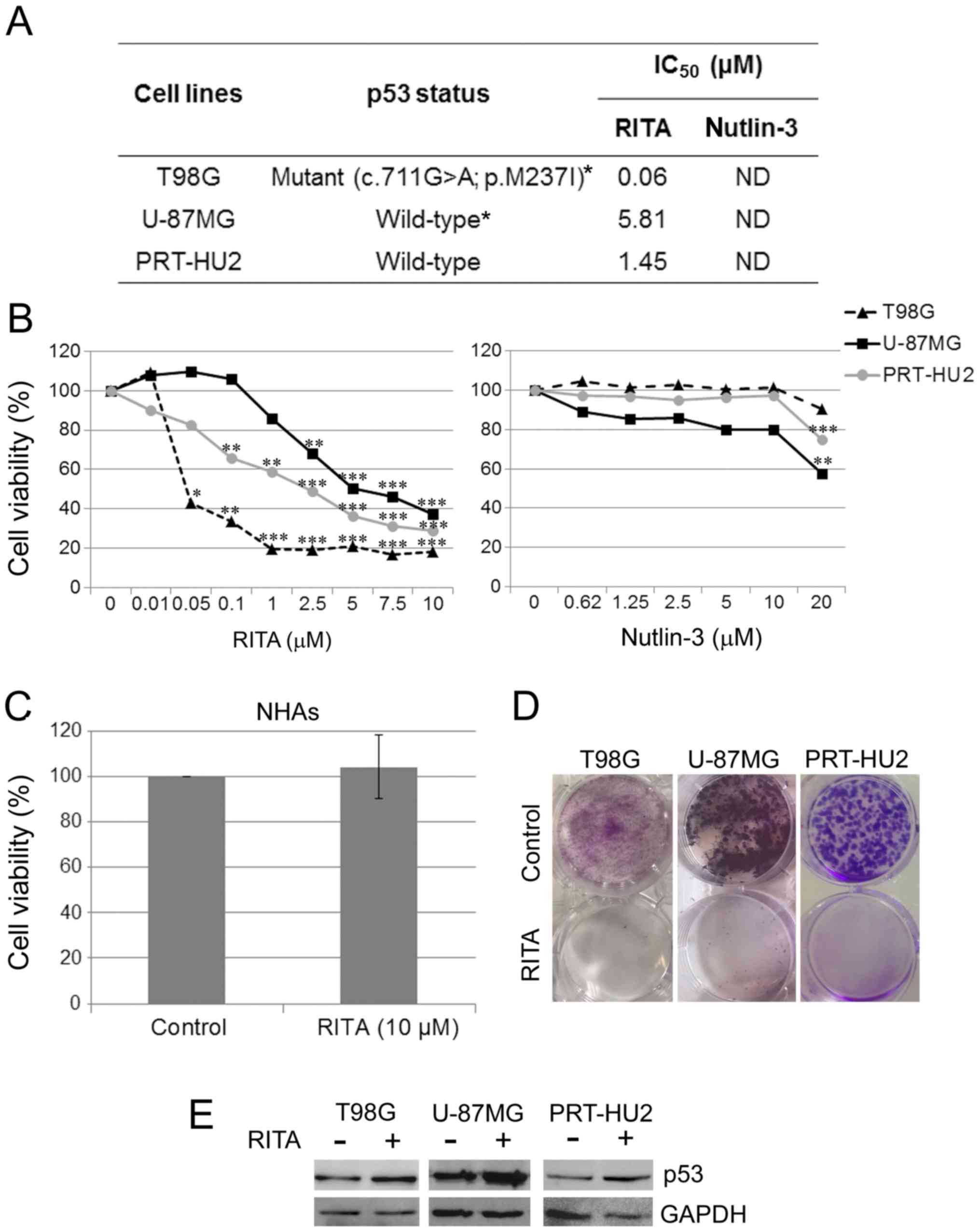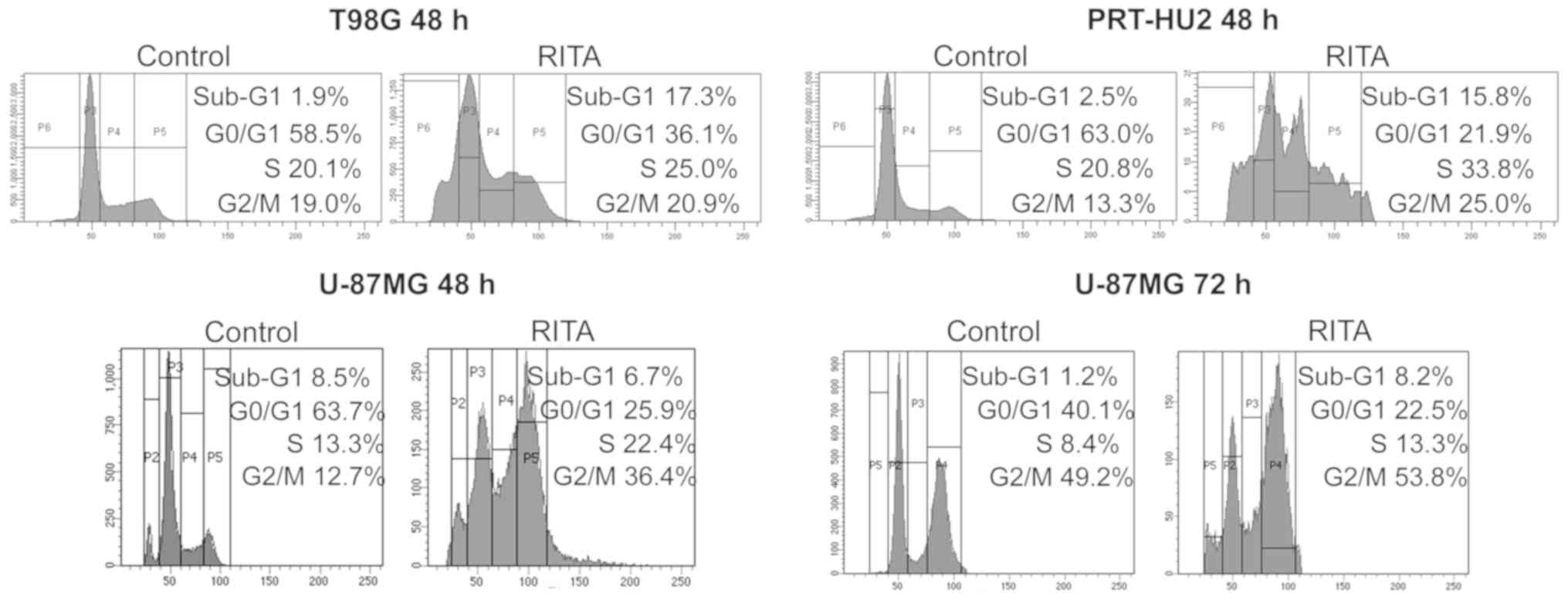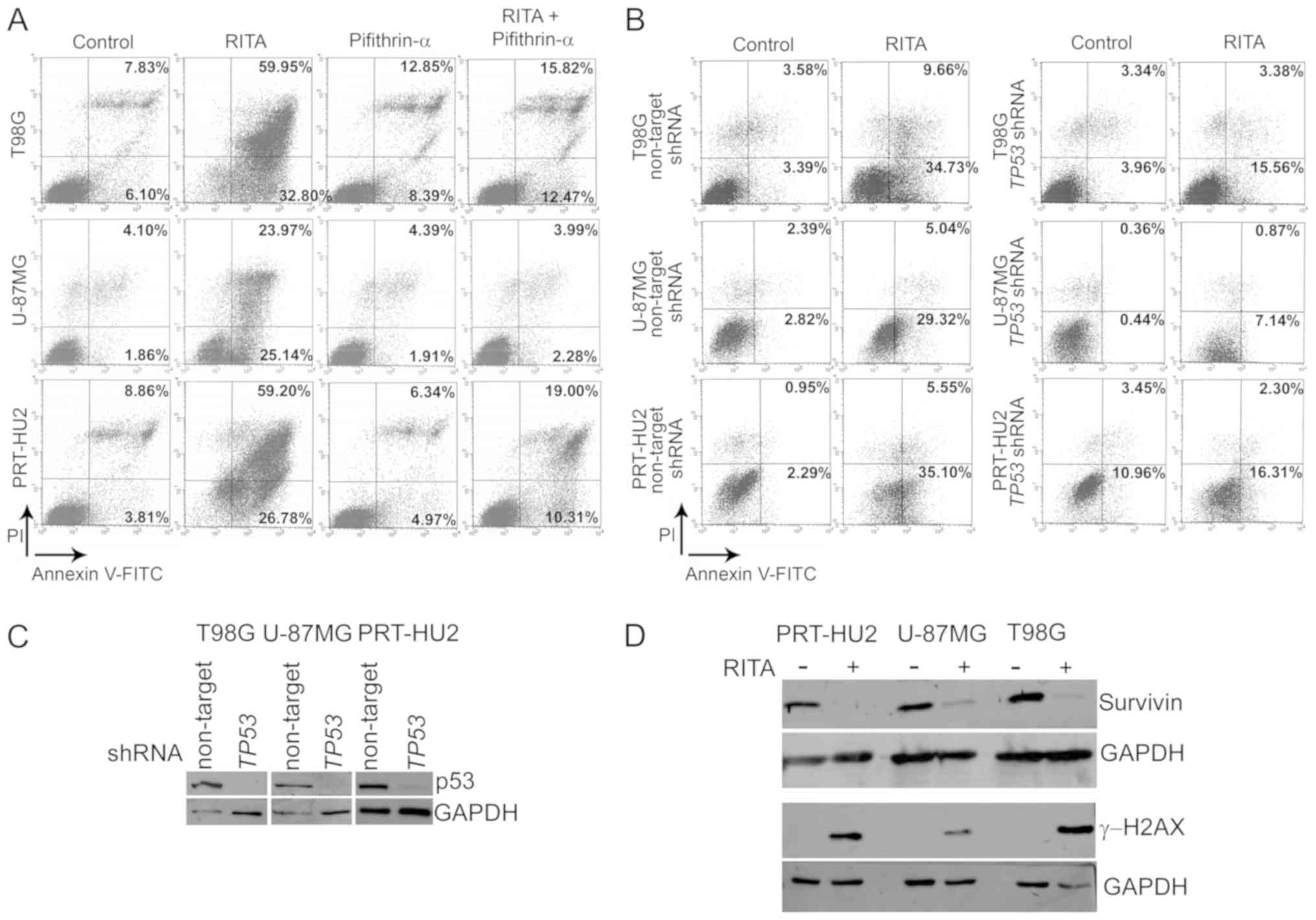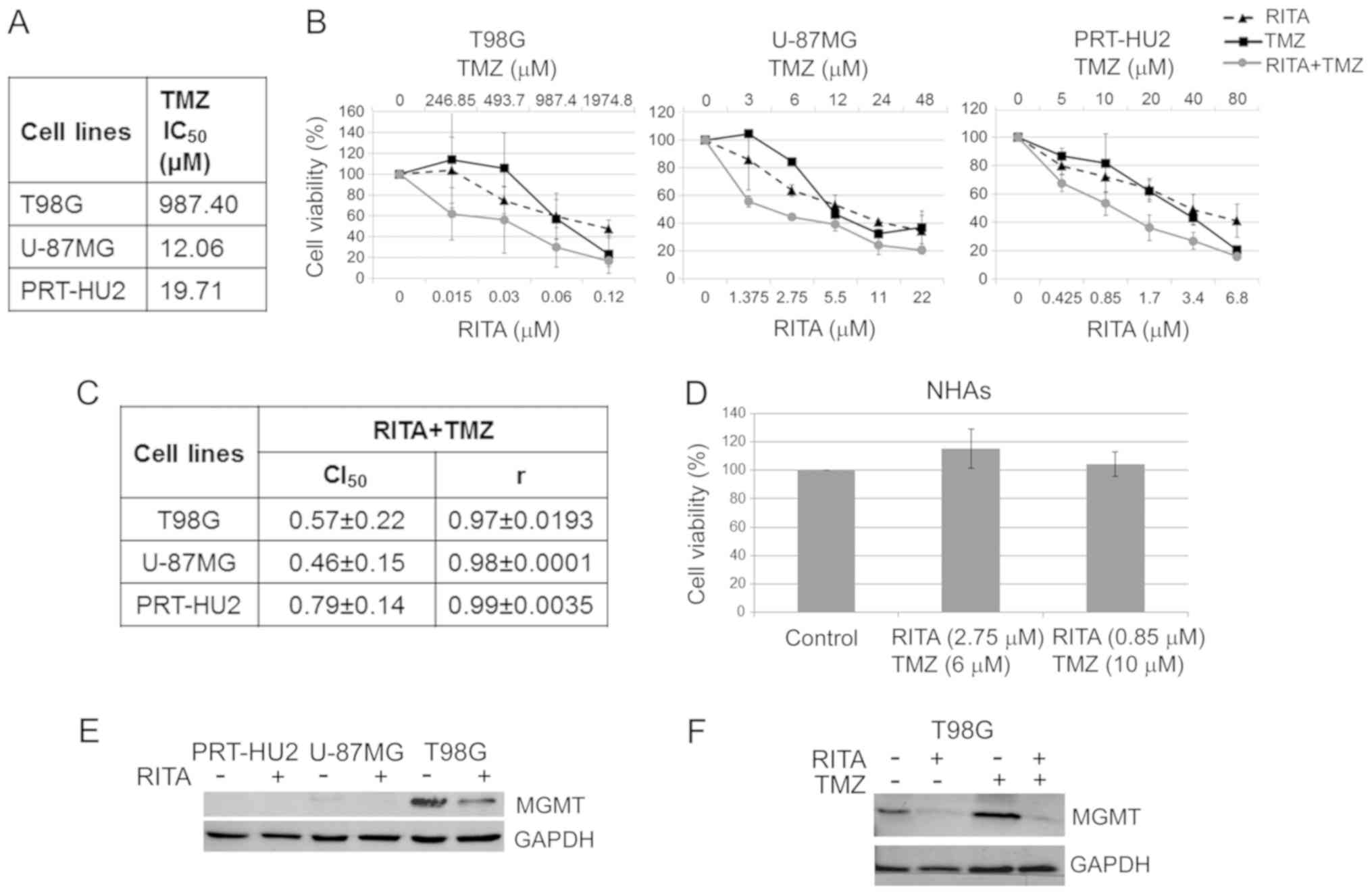Targeted therapy based on p53 reactivation reduces both glioblastoma cell growth and resistance to temozolomide
- Authors:
- Iris Maria Forte
- Paola Indovina
- Carmelina Antonella Iannuzzi
- Donatella Cirillo
- Domenico Di Marzo
- Daniela Barone
- Francesca Capone
- Francesca Pentimalli
- Antonio Giordano
-
Affiliations: Cell Biology and Biotherapy Unit, Istituto Nazionale Tumori ‑ IRCCS ‑ Fondazione G. Pascale, I‑80131 Napoli, Italy, Sbarro Institute for Cancer Research and Molecular Medicine, Center for Biotechnology, College of Science and Technology, Temple University, Philadelphia, PA 19122, USA, Experimental Pharmacology Unit, Istituto Nazionale Tumori ‑ IRCCS ‑ Fondazione G. Pascale, I‑80131 Napoli, Italy - Published online on: April 16, 2019 https://doi.org/10.3892/ijo.2019.4788
- Pages: 2189-2199
This article is mentioned in:
Abstract
 |
 |
 |
 |
|
Omuro A and DeAngelis LM: Glioblastoma and other malignant gliomas: A clinical review. JAMA. 310:1842–1850. 2013. View Article : Google Scholar : PubMed/NCBI | |
|
Louis DN, Perry A, Reifenberger G, von Deimling A, Figarella-Branger D, Cavenee WK, Ohgaki H, Wiestler OD, Kleihues P and Ellison DW: The 2016 World Health Organization Classification of Tumors of the Central Nervous System: A summary. Acta Neuropathol. 131:803–820. 2016. View Article : Google Scholar : PubMed/NCBI | |
|
Stupp R, Mason WP, van den Bent MJ, Weller M, Fisher B, Taphoorn MJ, Belanger K, Brandes AA, Marosi C, Bogdahn U, et al European Organisation for Research and Treatment of Cancer Brain Tumor and Radiotherapy Groups; National Cancer Institute of Canada Clinical Trials Group: Radiotherapy plus concomitant and adjuvant temozolomide for glioblastoma. N Engl J Med. 352:987–996. 2005. View Article : Google Scholar : PubMed/NCBI | |
|
Perry JR, Laperriere N, O’Callaghan CJ, Brandes AA, Menten J, Phillips C, Fay M, Nishikawa R, Cairncross JG, Roa W, et al Trial Investigators: Short-course radiation plus temozolomide in elderly patients with glioblastoma. N Engl J Med. 376:1027–1037. 2017. View Article : Google Scholar : PubMed/NCBI | |
|
Wen PY and Kesari S: Malignant gliomas in adults. N Engl J Med. 359:492–507. 2008. View Article : Google Scholar : PubMed/NCBI | |
|
Cancer Genome Atlas Research Network: Comprehensive genomic characterization defines human glioblastoma genes and core pathways. Nature. 455:1061–1068. 2008. View Article : Google Scholar : PubMed/NCBI | |
|
Shajani-Yi Z, de Abreu FB, Peterson JD and Tsongalis GJ: Frequency of somatic TP53 mutations in combination with known pathogenic mutations in colon adenocarcinoma, non-small cell lung carcinoma, and gliomas as identified by mext-generation sequencing. Neoplasia. 20:256–262. 2018. View Article : Google Scholar : PubMed/NCBI | |
|
Ohgaki H, Dessen P, Jourde B, Horstmann S, Nishikawa T, Di Patre PL, Burkhard C, Schüler D, Probst-Hensch NM, Maiorka PC, et al: Genetic pathways to glioblastoma: A population-based study. Cancer Res. 64:6892–6899. 2004. View Article : Google Scholar : PubMed/NCBI | |
|
Kleihues P, Schäuble B, zur Hausen A, Estève J and Ohgaki H: Tumors associated with p53 germline mutations: A synopsis of 91 families. Am J Pathol. 150:1–13. 1997.PubMed/NCBI | |
|
Wang Y, Yang J, Zheng H, Tomasek GJ, Zhang P, McKeever PE, Lee EY and Zhu Y: Expression of mutant p53 proteins implicates a lineage relationship between neural stem cells and malignant astrocytic glioma in a murine model. Cancer Cell. 15:514–526. 2009. View Article : Google Scholar : PubMed/NCBI | |
|
Chow LM, Endersby R, Zhu X, Rankin S, Qu C, Zhang J, Broniscer A, Ellison DW and Baker SJ: Cooperativity within and among Pten, p53, and Rb pathways induces high-grade astro-cytoma in adult brain. Cancer Cell. 19:305–316. 2011. View Article : Google Scholar : PubMed/NCBI | |
|
England B, Huang T and Karsy M: Current understanding of the role and targeting of tumor suppressor p53 in glioblastoma multiforme. Tumour Biol. 34:2063–2074. 2013. View Article : Google Scholar : PubMed/NCBI | |
|
Kang YJ, Balter B, Csizmadia E, Haas B, Sharma H, Bronson R and Yan CT: Contribution of classical end-joining to PTEN inactivation in p53-mediated glioblastoma formation and drug-resistant survival. Nat Commun. 8:140132017. View Article : Google Scholar : PubMed/NCBI | |
|
Srivenugopal KS, Shou J, Mullapudi SR, Lang FF Jr, Rao JS and Ali-Osman F: Enforced expression of wild-type p53 curtails the transcription of the O(6)-methylguanine-DNA methyltransferase gene in human tumor cells and enhances their sensitivity to alkylating agents. Clin Cancer Res. 7:1398–1409. 2001.PubMed/NCBI | |
|
Sato A, Sunayama J, Matsuda K, Seino S, Suzuki K, Watanabe E, Tachibana K, Tomiyama A, Kayama T and Kitanaka C: MEK-ERK signaling dictates DNA-repair gene MGMT expression and temozolomide resistance of stem-like glioblastoma cells via the MDM2-p53 axis. Stem Cells. 29:1942–1951. 2011. View Article : Google Scholar : PubMed/NCBI | |
|
Messaoudi K, Clavreul A and Lagarce F: Toward an effective strategy in glioblastoma treatment Part I: Resistance mechanisms and strategies to overcome resistance of glioblastoma to temozolomide. Drug Discov Today. 20:899–905. 2015. View Article : Google Scholar : PubMed/NCBI | |
|
Wang X, Chen JX, Liu JP, You C, Liu YH and Mao Q: Gain of function of mutant TP53 in glioblastoma: Prognosis and response to temozolomide. Ann Surg Oncol. 21:1337–1344. 2014. View Article : Google Scholar | |
|
Ham SW, Jeon HY, Jin X, Kim EJ, Kim JK, Shin YJ, Lee Y, Kim SH, Lee SY, Seo S, et al: TP53 gain-of-function mutation promotes inflammation in glioblastoma. Cell Death Differ. May 21–2018.Epub ahead of print. View Article : Google Scholar | |
|
Pentimalli F: Updates from the TP53 universe. Cell Death Differ. 25:10–12. 2018. View Article : Google Scholar | |
|
Stegh AH: Targeting the p53 signaling pathway in cancer therapy - the promises, challenges and perils. Expert Opin Ther Targets. 16:67–83. 2012. View Article : Google Scholar : PubMed/NCBI | |
|
Pflaum J, Schlosser S and Müller M: p53 Family and cellular stress responses in cancer. Front Oncol. 4:2852014. View Article : Google Scholar : PubMed/NCBI | |
|
Merkel O, Taylor N, Prutsch N, Staber PB, Moriggl R, Turner SD and Kenner L: When the guardian sleeps: Reactivation of the p53 pathway in cancer. Mutat Res. 773:1–13. 2017. View Article : Google Scholar : PubMed/NCBI | |
|
Kim SS, Rait A, Kim E, Pirollo KF, Nishida M, Farkas N, Dagata JA and Chang EH: A nanoparticle carrying the p53 gene targets tumors including cancer stem cells, sensitizes glio-blastoma to chemotherapy and improves survival. ACS Nano. 8:5494–5514. 2014. View Article : Google Scholar : PubMed/NCBI | |
|
Kim SS, Rait A, Kim E, Pirollo KF and Chang EH: A tumor-targeting p53 nanodelivery system limits chemore-sistance to temozolomide prolonging survival in a mouse model of glioblastoma multiforme. Nanomedicine (Lond). 11:301–311. 2015. View Article : Google Scholar | |
|
Wischhusen J, Naumann U, Ohgaki H, Rastinejad F and Weller M: CP-31398, a novel p53-stabilizing agent, induces p53-dependent and p53-independent glioma cell death. Oncogene. 22:8233–8245. 2003. View Article : Google Scholar : PubMed/NCBI | |
|
Weinmann L, Wischhusen J, Demma MJ, Naumann U, Roth P, Dasmahapatra B and Weller M: A novel p53 rescue compound induces p53-dependent growth arrest and sensitises glioma cells to Apo2L/TRAIL-induced apoptosis. Cell Death Differ. 15:718–729. 2008. View Article : Google Scholar : PubMed/NCBI | |
|
Villalonga-Planells R, Coll-Mulet L, Martínez-Soler F, Castaño E, Acebes JJ, Giménez-Bonafé P, Gil J and Tortosa A: Activation of p53 by nutlin-3a induces apoptosis and cellular senescence in human glioblastoma multiforme. PLoS One. 6:e185882011. View Article : Google Scholar : PubMed/NCBI | |
|
Costa B, Bendinelli S, Gabelloni P, Da Pozzo E, Daniele S, Scatena F, Vanacore R, Campiglia P, Bertamino A, Gomez-Monterrey I, et al: Human glioblastoma multiforme: p53 reactivation by a novel MDM2 inhibitor. PLoS One. 8:e722812013. View Article : Google Scholar : PubMed/NCBI | |
|
Daniele S, Taliani S, Da Pozzo E, Giacomelli C, Costa B, Trincavelli ML, Rossi L, La Pietra V, Barresi E, Carotenuto A, et al: Apoptosis therapy in cancer: The first single-molecule co-activating p53 and the translocator protein in glioblastoma. Sci Rep. 4:47492014. View Article : Google Scholar : PubMed/NCBI | |
|
Chen X, Tai L, Gao J, Qian J, Zhang M, Li B, Xie C, Lu L and Lu W and Lu W: A stapled peptide antagonist of MDM2 carried by polymeric micelles sensitizes glioblastoma to temozolomide treatment through p53 activation. J Control Release. 218:29–35. 2015. View Article : Google Scholar : PubMed/NCBI | |
|
Daniele S, Barresi E, Zappelli E, Marinelli L, Novellino E, Da Settimo F, Taliani S, Trincavelli ML and Martini C: Long lasting MDM2/Translocator protein modulator: A new strategy for irreversible apoptosis of human glioblastoma cells. Oncotarget. 7:7866–7884. 2016. View Article : Google Scholar : PubMed/NCBI | |
|
Daniele S, Costa B, Zappelli E, Da Pozzo E, Sestito S, Nesi G, Campiglia P, Marinelli L, Novellino E, Rapposelli S, et al: Combined inhibition of AKT/mTOR and MDM2 enhances Glioblastoma Multiforme cell apoptosis and differentiation of cancer stem cells. Sci Rep. 5:99562015. View Article : Google Scholar : PubMed/NCBI | |
|
Daniele S, La Pietra V, Barresi E, Di Maro S, Da Pozzo E, Robello M, La Motta C, Cosconati S, Taliani S, Marinelli L, et al: Lead optimization of 2-phenylindolylglyoxylyldipeptide murine double minute (MDM)2/translocator protein (TSPO) dual inhibitors for the treatment of gliomas. J Med Chem. 59:4526–4538. 2016. View Article : Google Scholar : PubMed/NCBI | |
|
Patyka M, Sharifi Z, Petrecca K, Mansure J, Jean-Claude B and Sabri S: Sensitivity to PRIMA-1MET is associated with decreased MGMT in human glioblastoma cells and glioblastoma stem cells irrespective of p53 status. Oncotarget. 7:60245–60269. 2016. View Article : Google Scholar : PubMed/NCBI | |
|
Verreault M, Schmitt C, Goldwirt L, Pelton K, Haidar S, Levasseur C, Guehennec J, Knoff D, Labussière M, Marie Y, et al: Preclinical efficacy of the MDM2 inhibitor RG7112 in MDM2-amplified and TP53 wild-type glio-blastomas. Clin Cancer Res. 22:1185–1196. 2016. View Article : Google Scholar | |
|
Renner G, Janouskova H, Noulet F, Koenig V, Guerin E, Bär S, Nuesch J, Rechenmacher F, Neubauer S, Kessler H, et al: Integrin α5β1 and p53 convergent pathways in the control of anti-apoptotic proteins PEA-15 and survivin in high-grade glioma. Cell Death Differ. 23:640–653. 2016. View Article : Google Scholar | |
|
Wang H, Cai S, Bailey BJ, Reza Saadatzadeh M, Ding J, Tonsing-Carter E, Georgiadis TM, Zachary Gunter T, Long EC, Minto RE, et al: Combination therapy in a xenograft model of glio-blastoma: Enhancement of the antitumor activity of temozolomide by an MDM2 antagonist. J Neurosurg. 126:446–459. 2017. View Article : Google Scholar | |
|
Mai WX, Gosa L, Daniels VW, Ta L, Tsang JE, Higgins B, Gilmore WB, Bayley NA, Harati MD, Lee JT, et al: Cytoplasmic p53 couples oncogene-driven glucose metabolism to apoptosis and is a therapeutic target in glioblastoma. Nat Med. 23:1342–1351. 2017. View Article : Google Scholar : PubMed/NCBI | |
|
Merlino F, Daniele S, La Pietra V, Di Maro S, Di Leva FS, Brancaccio D, Tomassi S, Giuntini S, Cerofolini L, Fragai M, et al: Simultaneous targeting of RGD-integrins and dual murine double minute proteins in glioblastoma multiforme. J Med Chem. 61:4791–4809. 2018. View Article : Google Scholar : PubMed/NCBI | |
|
Issaeva N, Bozko P, Enge M, Protopopova M, Verhoef LG, Masucci M, Pramanik A and Selivanova G: Small molecule RITA binds to p53, blocks p53-HDM-2 interaction and activates p53 function in tumors. Nat Med. 10:1321–1328. 2004. View Article : Google Scholar : PubMed/NCBI | |
|
Dickinson ER, Jurneczko E, Nicholson J, Hupp TR, Zawacka-Pankau J, Selivanova G and Barran PE: The use of ion mobility mass spectrometry to probe modulation of the structure of p53 and of MDM2 by small molecule inhibitors. Front Mol Biosci. 2:392015. View Article : Google Scholar : PubMed/NCBI | |
|
Krajewski M, Ozdowy P, D’Silva L, Rothweiler U and Holak TA: NMR indicates that the small molecule RITA does not block p53-MDM2 binding in vitro. Nat Med. 11:1135–1136; author reply 1136–1137. 2005. View Article : Google Scholar : PubMed/NCBI | |
|
Du Z, Yu J, Li F, Deng L, Wu F, Huang X, Bergstrand J, Widengren J, Dong C and Ren J: In situ monitoring of p53 protein and MDM2 protein interaction in single living cells using single-molecule fluorescence spectroscopy. Anal Chem. 90:6144–6151. 2018. View Article : Google Scholar : PubMed/NCBI | |
|
Di Conza G, Buttarelli M, Monti O, Pellegrino M, Mancini F, Pontecorvi A, Scotlandi K and Moretti F: IGF-1R/MDM2 relationship confers enhanced sensitivity to RITA in Ewing sarcoma cells. Mol Cancer Ther. 11:1247–1256. 2012. View Article : Google Scholar : PubMed/NCBI | |
|
Henze J, Mühlenberg T, Simon S, Grabellus F, Rubin B, Taeger G, Schuler M, Treckmann J, Debiec-Rychter M, Taguchi T, et al: p53 modulation as a therapeutic strategy in gastrointestinal stromal tumors. PLoS One. 7:e377762012. View Article : Google Scholar : PubMed/NCBI | |
|
Chuang HC, Yang LP, Fitzgerald AL, Osman A, Woo SH, Myers JN and Skinner HD: The p53-reactivating small molecule RITA induces senescence in head and neck cancer cells. PLoS One. 9:e1048212014. View Article : Google Scholar : PubMed/NCBI | |
|
Surget S, Descamps G, Brosseau C, Normant V, Maïga S, Gomez-Bougie P, Gouy-Colin N, Godon C, Béné MC, Moreau P, et al: RITA (Reactivating p53 and Inducing Tumor Apoptosis) is efficient against TP53abnormal myeloma cells independently of the p53 pathway. BMC Cancer. 14:4372014. View Article : Google Scholar | |
|
Weilbacher A, Gutekunst M, Oren M, Aulitzky WE and van der Kuip H: RITA can induce cell death in p53-defective cells independently of p53 function via activation of JNK/SAPK and p38. Cell Death Dis. 5:e13182014. View Article : Google Scholar : PubMed/NCBI | |
|
Wanzel M, Vischedyk JB, Gittler MP, Gremke N, Seiz JR, Hefter M, Noack M, Savai R, Mernberger M, Charles JP, et al: CRISPR-Cas9-based target validation for p53-reactivating model compounds. Nat Chem Biol. 12:22–28. 2016. View Article : Google Scholar : | |
|
Hedström E, Eriksson S, Zawacka-Pankau J, Arnér ES and Selivanova G: p53-dependent inhibition of TrxR1 contributes to the tumor-specific induction of apoptosis by RITA. Cell Cycle. 8:3584–3591. 2009. View Article : Google Scholar : PubMed/NCBI | |
|
Shi Y, Nikulenkov F, Zawacka-Pankau J, Li H, Gabdoulline R, Xu J, Eriksson S, Hedström E, Issaeva N, Kel A, et al: ROS-dependent activation of JNK converts p53 into an efficient inhibitor of oncogenes leading to robust apoptosis. Cell Death Differ. 21:612–623. 2014. View Article : Google Scholar : PubMed/NCBI | |
|
Saha MN, Jiang H, Yang Y, Zhu X, Wang X, Schimmer AD, Qiu L and Chang H: Targeting p53 via JNK pathway: A novel role of RITA for apoptotic signaling in multiple myeloma. PLoS One. 7:e302152012. View Article : Google Scholar : PubMed/NCBI | |
|
Nieves-Neira W, Rivera MI, Kohlhagen G, Hursey ML, Pourquier P, Sausville EA and Pommier Y: DNA protein cross-links produced by NSC 652287, a novel thiophene derivative active against human renal cancer cells. Mol Pharmacol. 56:478–484. 1999. View Article : Google Scholar : PubMed/NCBI | |
|
Yang J, Ahmed A, Poon E, Perusinghe N, de Haven Brandon A, Box G, Valenti M, Eccles S, Rouschop K, Wouters B, et al: Small-molecule activation of p53 blocks hypoxia-inducible factor 1alpha and vascular endothelial growth factor expression in vivo and leads to tumor cell apoptosis in normoxia and hypoxia. Mol Cell Biol. 29:2243–2253. 2009. View Article : Google Scholar : PubMed/NCBI | |
|
Ahmed A, Yang J, Maya-Mendoza A, Jackson DA and Ashcroft M: Pharmacological activation of a novel p53-dependent S-phase checkpoint involving CHK-1. Cell Death Dis. 2:e1602011. View Article : Google Scholar : PubMed/NCBI | |
|
de Lange J, Verlaan-de Vries M, Teunisse AF and Jochemsen AG: Chk2 mediates RITA-induced apoptosis. Cell Death Differ. 19:980–989. 2012. View Article : Google Scholar : | |
|
Wiegering A, Matthes N, Mühling B, Koospal M, Quenzer A, Peter S, Germer CT, Linnebacher M and Otto C: Reactivating p53 and Inducing Tumor Apoptosis (RITA) Enhances the Response of RITA-Sensitive Colorectal Cancer Cells to Chemotherapeutic Agents 5-Fluorouracil and Oxaliplatin. Neoplasia. 19:301–309. 2017. View Article : Google Scholar : PubMed/NCBI | |
|
Grinkevich VV, Nikulenkov F, Shi Y, Enge M, Bao W, Maljukova A, Gluch A, Kel A, Sangfelt O and Selivanova G: Ablation of key oncogenic pathways by RITA-reactivated p53 is required for efficient apoptosis. Cancer Cell. 15:441–453. 2009. View Article : Google Scholar : PubMed/NCBI | |
|
Enge M, Bao W, Hedström E, Jackson SP, Moumen A and Selivanova G: MDM2-dependent downregulation of p21 and hnRNP K provides a switch between apoptosis and growth arrest induced by pharmacologically activated p53. Cancer Cell. 15:171–183. 2009. View Article : Google Scholar : PubMed/NCBI | |
|
Di Marzo D, Forte IM, Indovina P, Di Gennaro E, Rizzo V, Giorgi F, Mattioli E, Iannuzzi CA, Budillon A, Giordano A, et al: Pharmacological targeting of p53 through RITA is an effective antitumoral strategy for malignant pleural mesothelioma. Cell Cycle. 13:652–665. 2014. View Article : Google Scholar | |
|
Saha MN, Jiang H, Mukai A and Chang H: RITA inhibits multiple myeloma cell growth through induction of p53-mediated caspase-dependent apoptosis and synergistically enhances nutlin-induced cytotoxic responses. Mol Cancer Ther. 9:3041–3051. 2010. View Article : Google Scholar : PubMed/NCBI | |
|
Shin D, Kim EH, Lee J and Roh JL: RITA plus 3-MA overcomes chemoresistance of head and neck cancer cells via dual inhibition of autophagy and antioxidant systems. Redox Biol. 13:219–227. 2017. View Article : Google Scholar : PubMed/NCBI | |
|
Zhao CY, Grinkevich VV, Nikulenkov F, Bao W and Selivanova G: Rescue of the apoptotic-inducing function of mutant p53 by small molecule RITA. Cell Cycle. 9:1847–1855. 2010. View Article : Google Scholar : PubMed/NCBI | |
|
Jones RJ, Bjorklund CC, Baladandayuthapani V, Kuhn DJ and Orlowski RZ: Drug resistance to inhibitors of the human double minute-2 E3 ligase is mediated by point mutations of p53, but can be overcome with the p53 targeting agent RITA. Mol Cancer Ther. 11:2243–2253. 2012. View Article : Google Scholar : PubMed/NCBI | |
|
Burmakin M, Shi Y, Hedström E, Kogner P and Selivanova G: Dual targeting of wild-type and mutant p53 by small molecule RITA results in the inhibition of N-Myc and key survival oncogenes and kills neuroblastoma cells in vivo and in vitro. Clin Cancer Res. 19:5092–5103. 2013. View Article : Google Scholar : PubMed/NCBI | |
|
Fiorini C, Cordani M, Padroni C, Blandino G, Di Agostino S and Donadelli M: Mutant p53 stimulates chemoresistance of pancreatic adenocarcinoma cells to gemcitabine. Biochim Biophys Acta. 1853:89–100. 2015. View Article : Google Scholar | |
|
Menendez D, Lowe JM, Snipe J and Resnick MA: Ligand dependent restoration of human TLR3 signaling and death in p53 mutant cells. Oncotarget. 7:61630–61642. 2016. View Article : Google Scholar : PubMed/NCBI | |
|
He XY, Feng XL, Song XP, Zeng HC, Cao ZX, Xiao WW, Zhang B and Wu QH: RITA combined with temozolomide inhibits the proliferation of human glioblastoma U87 cells. Nan Fang Yi Ke Da Xue Xue Bao. 36:1423–1428. 2016.In Chinese. PubMed/NCBI | |
|
Bacciocchi G, Gibelli N, Zibera C, Pedrazzoli P, Bergamaschi G, De Piceis Polver P, Danova M, Mazzini G, Palomba L, Tupler R, et al: Establishment and characterization of two cell lines derived from human glioblastoma multiforme. Anticancer Res. 12:853–861. 1992.PubMed/NCBI | |
|
Wang X, Chen JX, Liu YH, You C and Mao Q: Mutant TP53 enhances the resistance of glioblastoma cells to temozolomide by up-regulating O(6)-methylguanine DNA-methyltransferase. Neurol Sci. 34:1421–1428. 2013. View Article : Google Scholar | |
|
Komarov PG, Komarova EA, Kondratov RV, Christov-Tselkov K, Coon JS, Chernov MV and Gudkov AV: A chemical inhibitor of p53 that protects mice from the side effects of cancer therapy. Science. 285:1733–1737. 1999. View Article : Google Scholar : PubMed/NCBI | |
|
Mirza A, McGuirk M, Hockenberry TN, Wu Q, Ashar H, Black S, Wen SF, Wang L, Kirschmeier P, Bishop WR, et al: Human survivin is negatively regulated by wild-type p53 and participates in p53-dependent apoptotic pathway. Oncogene. 21:2613–2622. 2002. View Article : Google Scholar : PubMed/NCBI | |
|
Hoffman WH, Biade S, Zilfou JT, Chen J and Murphy M: Transcriptional repression of the anti-apoptotic survivin gene by wild type p53. J Biol Chem. 277:3247–3257. 2002. View Article : Google Scholar | |
|
Uchida H, Tanaka T, Sasaki K, Kato K, Dehari H, Ito Y, Kobune M, Miyagishi M, Taira K, Tahara H, et al: Adenovirus-mediated transfer of siRNA against survivin induced apoptosis and attenuated tumor cell growth in vitro and in vivo. Mol Ther. 10:162–171. 2004. View Article : Google Scholar : PubMed/NCBI | |
|
Saito T, Sugiyama K, Takeshima Y, Amatya VJ, Yamasaki F, Takayasu T, Nosaka R, Muragaki Y, Kawamata T and Kurisu K: Prognostic implications of the subcellular localization of survivin in glioblastomas treated with radiotherapy plus concomitant and adjuvant temozolomide. J Neurosurg. 128:679–684. 2018. View Article : Google Scholar | |
|
Faccion RS, Bernardo PS, de Lopes GPF, Bastos LS, Teixeira CL, de Oliveira JA, Fernandes PV, Dubois LG, Chimelli L and Maia RC: p53 expression and subcellular survivin localization improve the diagnosis and prognosis of patients with diffuse astrocytic tumors. Cell Oncol (Dordr). 41:141–157. 2018. View Article : Google Scholar | |
|
Chakravarti A, Zhai GG, Zhang M, Malhotra R, Latham DE, Delaney MA, Robe P, Nestler U, Song Q and Loeffler J: Survivin enhances radiation resistance in primary human glioblastoma cells via caspase-independent mechanisms. Oncogene. 23:7494–7506. 2004. View Article : Google Scholar : PubMed/NCBI | |
|
Guvenc H, Pavlyukov MS, Joshi K, Kurt H, Banasavadi-Siddegowda YK, Mao P, Hong C, Yamada R, Kwon CH, Bhasin D, et al: Impairment of glioma stem cell survival and growth by a novel inhibitor for Survivin-Ran protein complex. Clin Cancer Res. 19:631–642. 2013. View Article : Google Scholar | |
|
Dahan P, Martinez Gala J, Delmas C, Monferran S, Malric L, Zentkowski D, Lubrano V, Toulas C, Cohen-Jonathan Moyal E and Lemarie A: Ionizing radiations sustain glioblastoma cell dedifferentiation to a stem-like phenotype through survivin: Possible involvement in radioresistance. Cell Death Dis. 5:e15432014. View Article : Google Scholar : PubMed/NCBI | |
|
Fenstermaker RA, Figel SA, Qiu J, Barone TA, Dharma SS, Winograd EK, Galbo PM, Wiltsie LM and Ciesielski MJ: Survivin monoclonal antibodies detect survivin cell surface expression and inhibit tumor growth in vivo. Clin Cancer Res. 24:2642–2652. 2018. View Article : Google Scholar : PubMed/NCBI | |
|
Lee SY: Temozolomide resistance in glioblastoma multiforme. Genes Dis. 3:198–210. 2016. View Article : Google Scholar : PubMed/NCBI | |
|
Chou TC and Talalay P: Quantitative analysis of dose-effect relationships: The combined effects of multiple drugs or enzyme inhibitors. Adv Enzyme Regul. 22:27–55. 1984. View Article : Google Scholar : PubMed/NCBI | |
|
Hermisson M, Klumpp A, Wick W, Wischhusen J, Nagel G, Roos W, Kaina B and Weller M: O6-methylguanine DNA meth-yltransferase and p53 status predict temozolomide sensitivity in human malignant glioma cells. J Neurochem. 96:766–776. 2006. View Article : Google Scholar : PubMed/NCBI | |
|
Gottlieb A, Althoff K, Grunewald L, Thor T, Odersky A, Schulte M, Deubzer HE, Heukamp L, Eggert A, Schramm A, et al: RITA displays anti-tumor activity in medulloblastomas independent of TP53 status. Oncotarget. 8:27882–27891. 2017. View Article : Google Scholar : PubMed/NCBI | |
|
Ziegler DS, Kung AL and Kieran MW: Anti-apoptosis mechanisms in malignant gliomas. J Clin Oncol. 26:493–500. 2008. View Article : Google Scholar : PubMed/NCBI | |
|
Sohn D, Graupner V, Neise D, Essmann F, Schulze-Osthoff K and Jänicke RU: Pifithrin-alpha protects against DNA damage-induced apoptosis downstream of mitochondria independent of p53. Cell Death Differ. 16:869–878. 2009. View Article : Google Scholar : PubMed/NCBI | |
|
Kitange GJ, Carlson BL, Schroeder MA, Grogan PT, Lamont JD, Decker PA, Wu W, James CD and Sarkaria JN: Induction of MGMT expression is associated with temozolomide resistance in glioblastoma xenografts. Neuro-oncol. 11:281–291. 2009. View Article : Google Scholar : |









